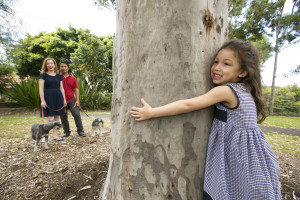Sydney’s canopy sprouts green, cool future

Sydney – October 11, 2015: Glebe residents Aileen, Jerome and Elyse (photo by Jamie Williams/City of Sydney)
I’m loving Sydney’s ongoing story of becoming a carbon neutral city. I think New Zealand should be looking to Sydney for an example of a city who has made a commitment and is aligning all it’s decisions with it’s goal. From counting every tree, to using old printer toner in the tar on their streets, Sydney is a living example of what’s possible for us here in Aotearoa too. So which Kiwi city’s going first?
Charlotte.
The City of Sydney is expanding its tree canopy to help green the city and has welcomed this week’s federal government commitment to further grow Australia’s urban forest.
The City’s own urban forest strategy aims to increase the canopy size by 50 per cent in the next 15 years, creating a city that is leafier, healthier and more liveable.
The 26 sq km local government area already has 30,219 street trees and 12,000 park trees in public spaces, worth $86 million in replacement value alone.
HAPPYZINE IS CROWD FUNDING! SIGN UP BEFORE JANUARY 31ST.
These trees help provide a total city canopy cover of nearly 16 per cent. Under the City’s urban forest strategy this will increase to more than 23 per cent by 2030 and to 27 per cent by 2050.
Lord Mayor Clover Moore welcomed the federal government’s announcement that it would work with major cities and set targets to increase canopy cover each decade through to 2050.
“The City applauds this commitment to increase tree coverage across Australian cities, to help tackle climate change, improve quality of life and reduce the urban heat island effect,” the Lord Mayor said.
“Trees make our streets more beautiful and add to the city’s character as well as improving our air, water and soil quality and providing habitat for birds and animals
“Every year one mature tree can absorb 3,400 litres of stormwater, filter 27 kilograms of pollutants from the air and provide a cooling effect.
“As our cities continue to rapidly grow in size and population, our increasing energy consumption and carbon emissions are placing a strain on our natural environment.
“Urban forests play a vital role in the health, social framework and economic sustainability of a city, and that’s why the City also has a target of increasing our urban canopy by 50 per cent by 2030.”
The City holds an annual free giveaway of 1,000 trees to help further green the community by encouraging residents to plant a tree in their own backyard.
The City’s urban forest manager, Karen Sweeney, said despite the urban conditions of the city centre, trees are growing well across the local government area.
“Planting avenues of trees and green corridors enhances the character of individual precincts and villages and can increase property prices,” Ms Sweeney said.
“Expanding the city’s tree canopy creates friendly spaces where residents, workers and visitors can relax in shaded, leafy pockets of calm in the heart of our bustling city.”
UTS researchers recently found that the City’s plans to increase tree canopy by 50 per cent could have a bigger impact on reducing air pollution than a reduction in traffic.
The year-long study, in collaboration with the City of Sydney, showed that inner city areas densely populated with trees, such as Glebe, experience reduced air pollution.
A register of significant trees now lists the city’s 1,931 most historic and important trees, including those with an outstanding height, trunk or canopy spread, association with an important historical event or local rarity as a species.
The City of Sydney also developed Australia’s first green roofs and walls policy that commits to working with the community and increasing the number of green living spaces on buildings.
Green roofs and walls have been around for decades, but have become increasingly popular in recent years with benefits for buildings including reduced noise pollution, lower energy costs for heating and cooling, and potential higher values for sales and leasing.
The urban canopy plan supports the City’s long-term target of reducing its carbon emissions by 70 per cent.
The City’s 2030 vision and program includes planting thousands of trees, introducing energy efficient LED street lights, installing solar panels on buildings, retrofitting buildings to improve energy efficiency and harvesting stormwater for a cleaner environment.
a WordPress rating system
a WordPress rating system



Voices of our community